White birds, particularly ones with long necks, are some of the most commonly seen birds throughout North and South America. These birds may all share gleaming white feathers, but their characteristics vary greatly from each other.
Table of Contents
While you may be familiar with white birds with long necks, such as the Stork or the Swan, there are also a few others worth knowing. In this article, you’ll explore 16 of these birds while learning about their unique characteristics and traits.
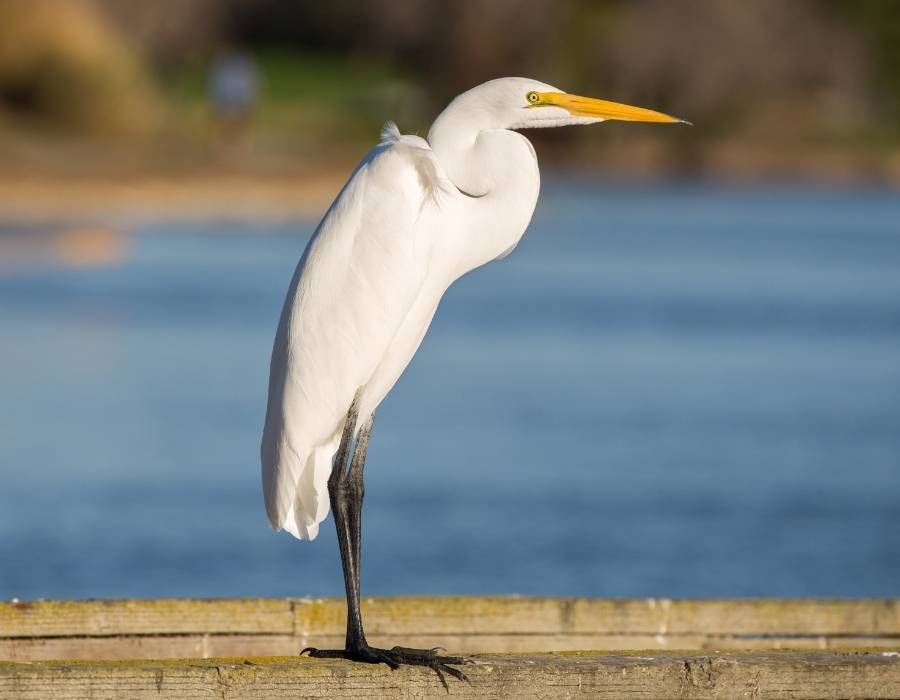
Key Takeaways
- White birds come in all shapes and sizes. Some are the size of crows, while others have bodies larger than the size of a football. Sometimes, the size of these birds doesn’t always correlate with their body weight, as birds must be lightweight in order to fly.
- The sound of a bird depends on its size, beak, and behavior. All birds have distinct sounds that allow them to communicate with other members of their species. While some birds may have a high-pitched squeal, others have a loud, low squawk.
- You’ll find that many birds, especially white birds with long necks, tend to live in wet areas near sources of water. Sometimes, these birds prefer swamps and wetlands, while others prefer more vast bodies of water such as lakes, rivers, and oceans.
Long Beaked Birds
In the vast realm of avian diversity, the top 15 white birds with long beaks hold a special place. These birds, resplendent in their snowy plumage, are a testament to the wonders of nature’s design.
Their long beaks, each uniquely adapted to their lifestyle, are a marvel of evolutionary engineering.
The Importance of Bird Diversity
Bird diversity is a vibrant tapestry of colors, shapes, and behaviors. The beak length and color of birds are not just aesthetic elements; they are crucial survival tools, honed by millions of years of evolution.
For instance, the American White Pelican uses its long beak for fishing, while the Great Egret uses its sharp beak to hunt small mammals and reptiles.
Understanding these birds and their unique characteristics is a journey into the heart of nature’s ingenuity, a journey that promises to be as enlightening as it is fascinating.
Great Egret
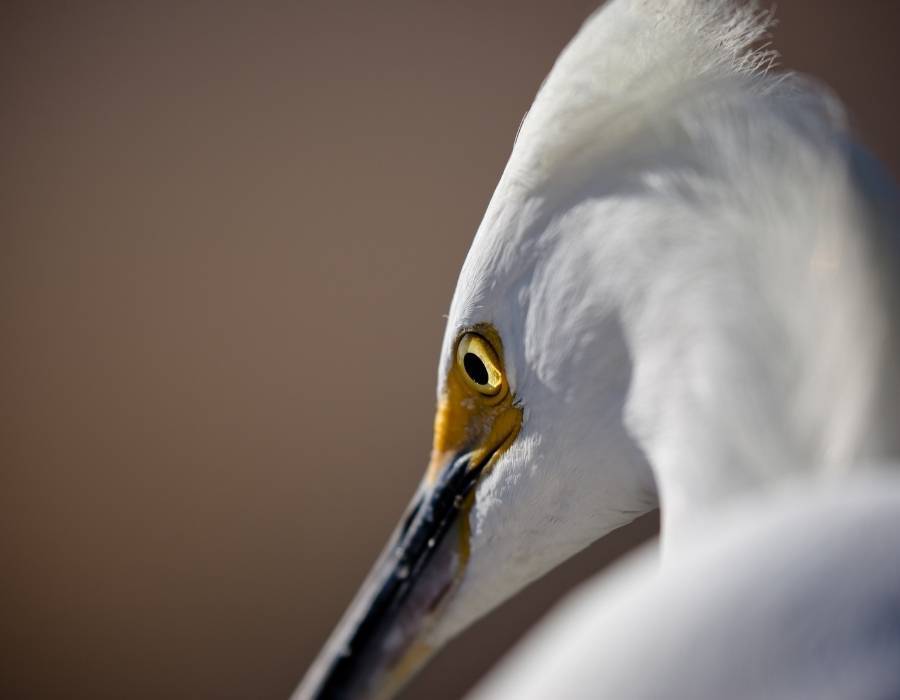
The Great Egret is an elegant bird with a slim body and long neck. This beautiful white bird also has a slim, pointed yellow beak that shines against its white feathers.
- Family: Ardeidae
- Size: Medium
- Wingspan: 51.6 – 57.1 in
- Weight: 35.3 oz
- Body: S-curved Neck
- Tail: Short
- Diet: Small fish
- Habitat: Freshwater and saltwater wetlands.
- Song: Dry, Nasal, Harsh, Croaking
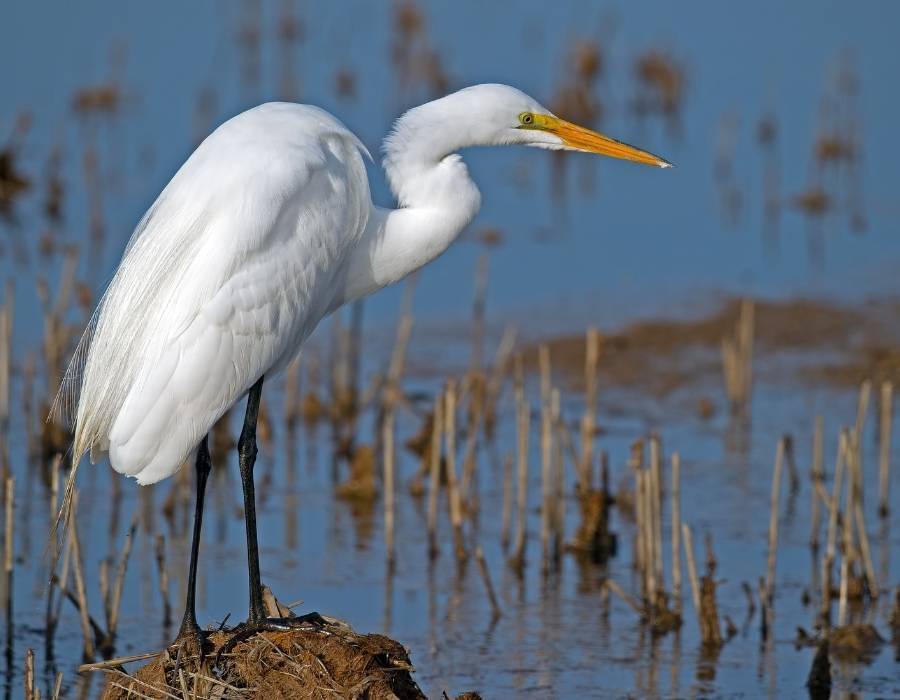
You can find this bird in many parts of both North and South America. These birds are known for hunting for food throughout the marshy wetlands, eating any small fish or insects they can find.
Click here for more information on the Great Egret.
More reading
Cattle Egret
The Cattle Egret, a small and enchanting avian species, possesses a striking appearance defined by its pure white plumage and sharp, pointed beak. This charming bird is frequently spotted in the company of livestock, taking advantage of the insects stirred up by these larger animals.
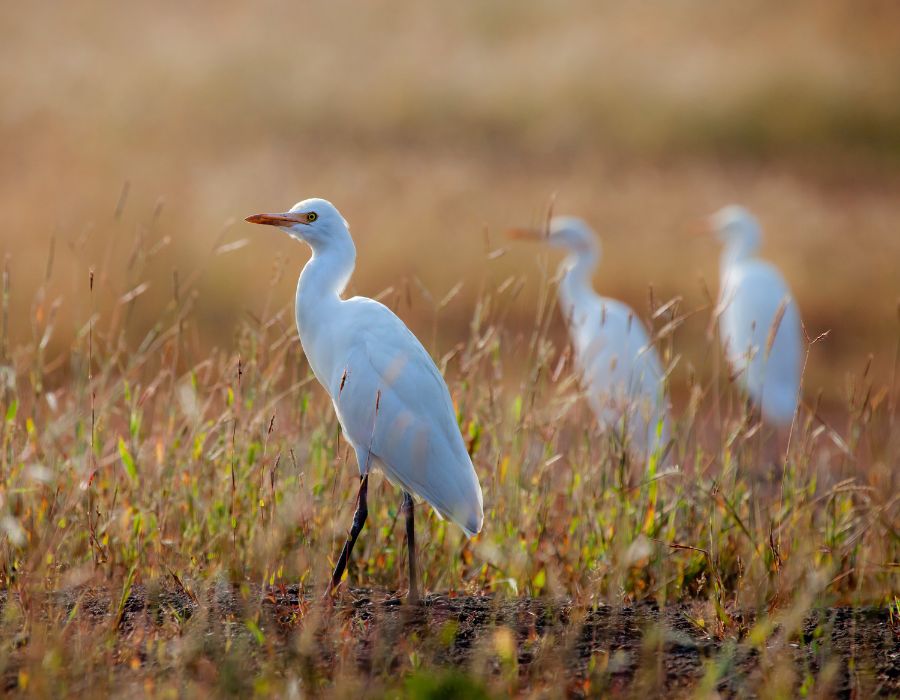
With its keen eye and specialized beak, the Cattle Egret skillfully captures its insect prey, making the most of the symbiotic relationship it shares with grazing animals. Spiritually, the Cattle Egret is seen as a symbol of adaptability and resourcefulness, reflecting its ability to thrive in various environments and its symbiotic relationship with livestock.
Why do birds have long beaks?
Birds have different beak shapes and sizes that are adapted to their specific diet and lifestyle. Here are a few reasons why some birds have long beaks:
- Feeding: Birds with long beaks often use them to reach food that other birds cannot. For example, hummingbirds have long, thin beaks that allow them to reach deep into flowers to drink nectar. Similarly, shorebirds like sandpipers and curlews have long beaks that they use to probe into mud and sand for insects, worms, and other invertebrates.
- Nesting: Some birds use their long beaks to help build nests. For instance, the long, strong beak of a woodpecker allows it to carve out holes in trees for nesting.
- Defense and Territory: A long beak can also be used for defense against predators or to establish territory among their own species.
- Courtship: In some species, a long beak might be a desirable trait during mating season. For example, in the case of the sword-billed hummingbird, the males with the longest beaks are often more attractive to females.
Remember, the shape and size of a bird’s beak is a result of millions of years of evolution, with each species developing a beak that helps it survive and thrive in its specific environment.
Snowy Egret
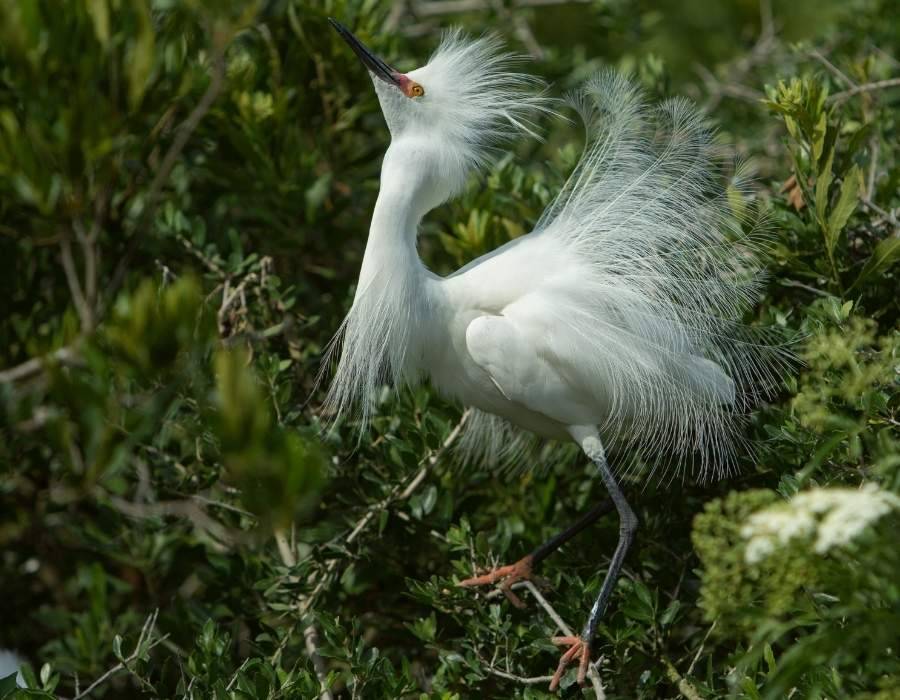
The Snowy Egret gets their name from their glacier-white wings. These slender birds can be identified by their snowy wings and slim bodies, soaring throughout the skies of Northern America and parts of South America.
- Family: Ardeidae
- Size: Medium
- Wingspan: 41 in
- Weight: 13oz
- Body: Short and slim
- Tail: Short
- Diet: Fish, shrimp, crayfish, crabs, snakes, snails, insects, and small lizards.
- Habitat: Marshes, lakes, coasts, ponds.
- Song: Nasal sounds, loud, harsh.
Currently, the Snowy Egret is critically endangered, and efforts to preserve these birds are in effect. Their population declined due to being poached and hunted for their wings, often popular choices for women’s hats.
Click here for more information on the Snowy Egret.
Trumpeter Swan
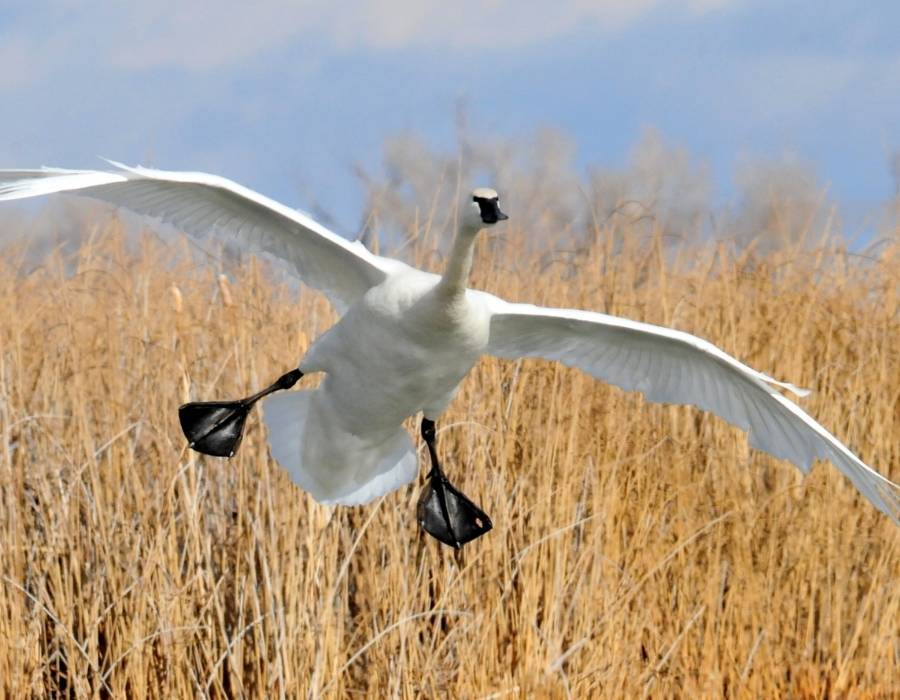
The trumpeter swan is one of the most beautiful and elegant birds native to North America. These birds have long been a symbol of grace, and beauty, often being associated with love and relationships.
- Family: Anatidae
- Size: Medium
- Wingspan: 53 – 98 inches
- Weight: 7.7 – 30 lb
- Body: Long s-curve neck, large, thick body.
- Tail: Short, Upward structure
- Diet: Plants, Molluscs, Insects
- Habitat: Rivers, Lakes
- Song: Deep, “OH” sound, Nasal
Trumpeter Swans are known for sticking with their mates for life. Some swans will even remain independent after their mate passes.
They are also one of the largest flying birds and are able to fly at great heights due to their lightweight, honeycomb-like bone structures.
Click here for more information on the Trumpeter Swan.
Further reading
Whooping Crane
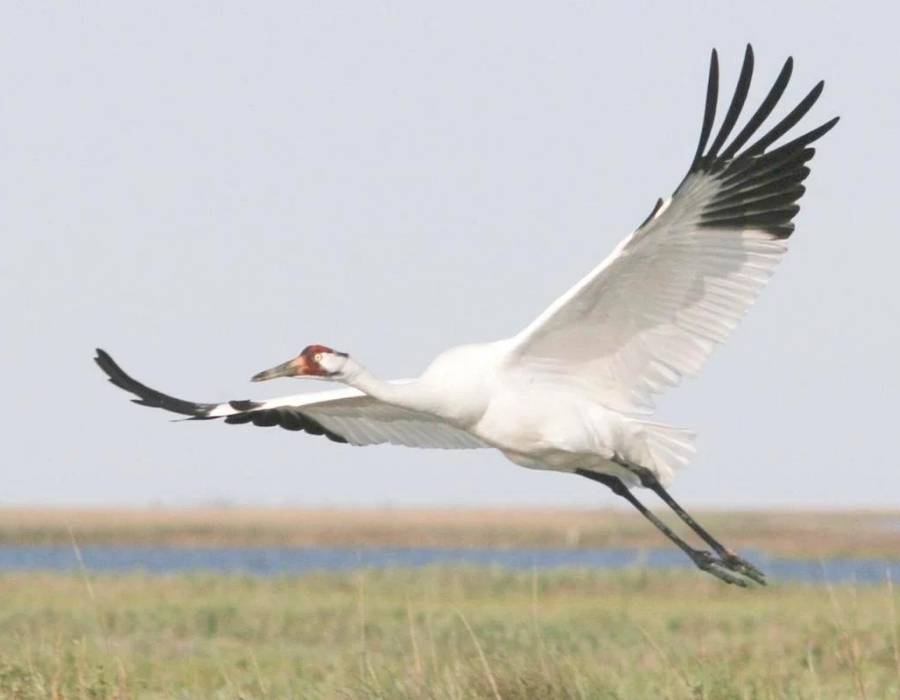
The Whooping Crane is a large, majestic bird with an impressive wingspan. It’s a rare sight to see a Whooping Crane soaring overhead, and truly a sight to see if you are lucky enough to experience it.
- Family: Gruidae
- Size: Large
- Wingspan: 7.5 ft
- Weight: 9.9 – 19 lb
- Body: Slender, Long skinny legs.
- Tail: Medium downward
- Diet: Small fish, insects, reptiles, amphibians.
- Habitat: Wetlands, Wet Prairies, Marshes
- Song: Loud whooping sounds.
In the 1940s, the Whooping Crane’s population declined to around 20 birds. Fortunately, conservation efforts have allowed their population to slowly climb to a much more manageable amount.
The Whooping Crane is also the tallest bird in North America due to their long, slender legs.
Click here for more information on the Whooping Crane.
Further reading
American White Pelican
The American White Pelican is a truly remarkable creature, captivating observers with its sheer grace and beauty. Renowned for its imposing size and stunning white plumage, this magnificent bird possesses an unmistakable presence.

Its long, flat beak, perfectly adapted for its feeding habits, allows it to skillfully scoop up fish, forming the cornerstone of its diet. In spiritual symbolism, the American White Pelican represents peace, cooperation, and teamwork, reflecting its social nature and collaborative hunting techniques.
Its presence serves as a reminder of the importance of community and the strength found in unity.
Dalmatian Pelican
As one of the world’s largest freshwater birds, the Dalmatian Pelican commands attention with its majestic presence. This impressive bird possesses a long, broad beak that perfectly aligns with its feeding habits.

Primarily relying on fish as its main source of sustenance, the Dalmatian Pelican’s beak is exquisitely adapted for catching its slippery prey. With a powerful sweep and lightning-fast precision, this magnificent bird skillfully maneuvers its beak through the water, securing nourishment with ease.
Spiritually, the Dalmatian Pelican symbolizes abundance, resilience, and community cooperation, reflecting its social behavior and adaptability.
White Stork
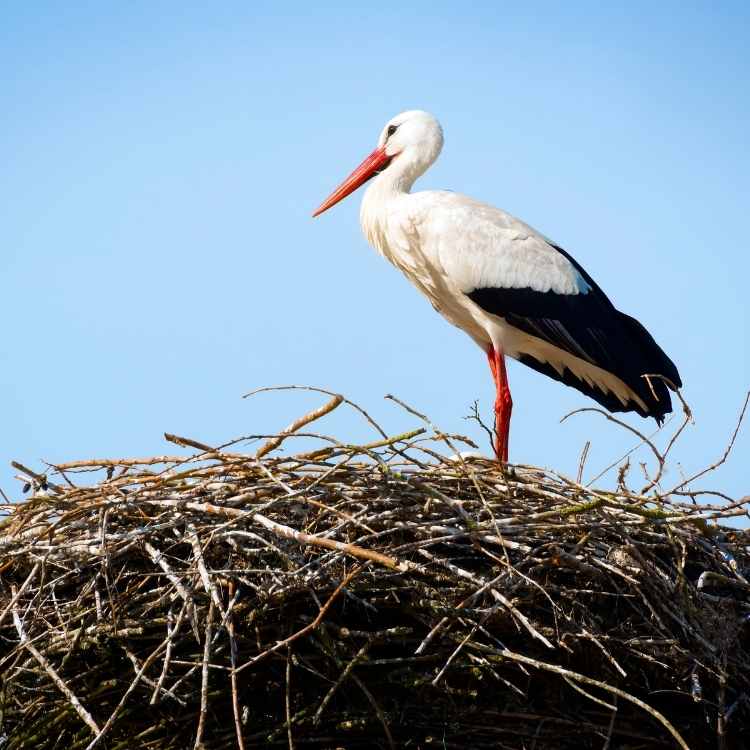
As a child, you may have been told that the Stork is responsible for bringing newborns to their families. While these birds may not actually deliver babies, they are one of the most giant birds in North America.
- Family: Ciconiidae
- Size: Large
- Wingspan: 5 – 7ft
- Weight: 5 – 10lb
- Body: Compact body, Medium curved neck.
- Tail: Long, downward, black feathers.
- Diet: Fish, Frogs, Snakes, Rodents, Lizards, Crustaceans, Spiders, Scorpions
- Habitat: Grassland, Freshwater, Wetlands, Savanna
- Song: Loud, Nasal, Donkey-like
Storks have the ability to live up to 30 years on average, and there are instances of these birds living close to 40 years old. While storks do have a loud, nasally sound, most of the time, these birds are silent and communicate much quieter than other birds.
Click here for more information on the Stork.
Also, check out this video for an in-depth look into the Stork’s story and association with where babies come from.
Further reading
Wood Stork
Exuding an aura of elegance and sophistication, the Wood Stork stands as a testament to nature’s mastery of design. Its elongated, curved beak is a marvel of adaptation, tailored to the stork’s unique foraging requirements.
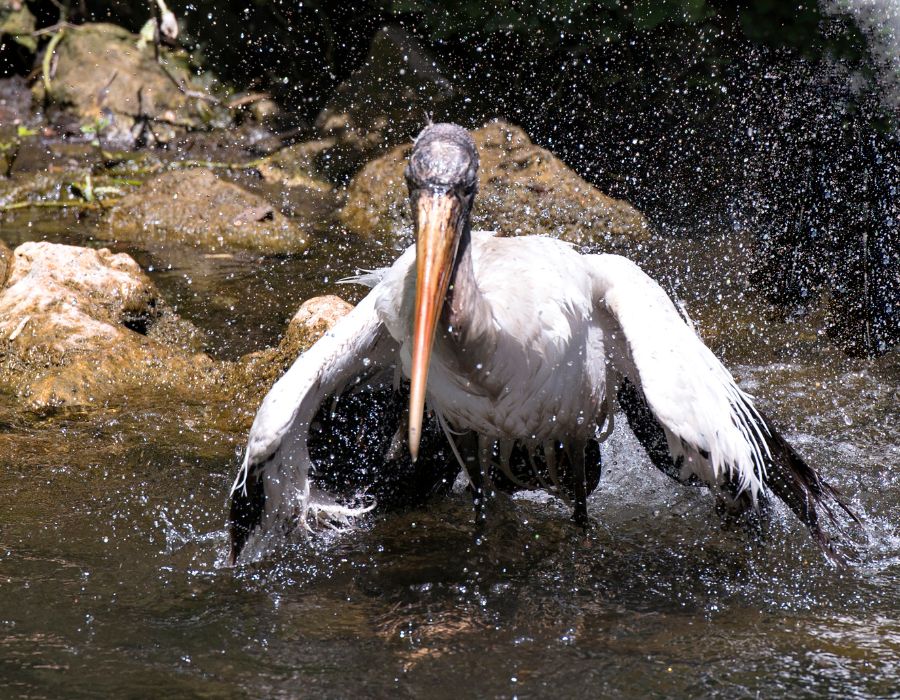
Thriving in shallow waters, this remarkable bird employs its distinctive beak to deftly search for prey and secure nourishment with precision. Spiritually, the Wood Stork symbolizes birth and renewal, often associated with the arrival of new opportunities and positive changes.
Its presence serves as a beacon of hope and a reminder of the cyclical nature of life.
White Ibis
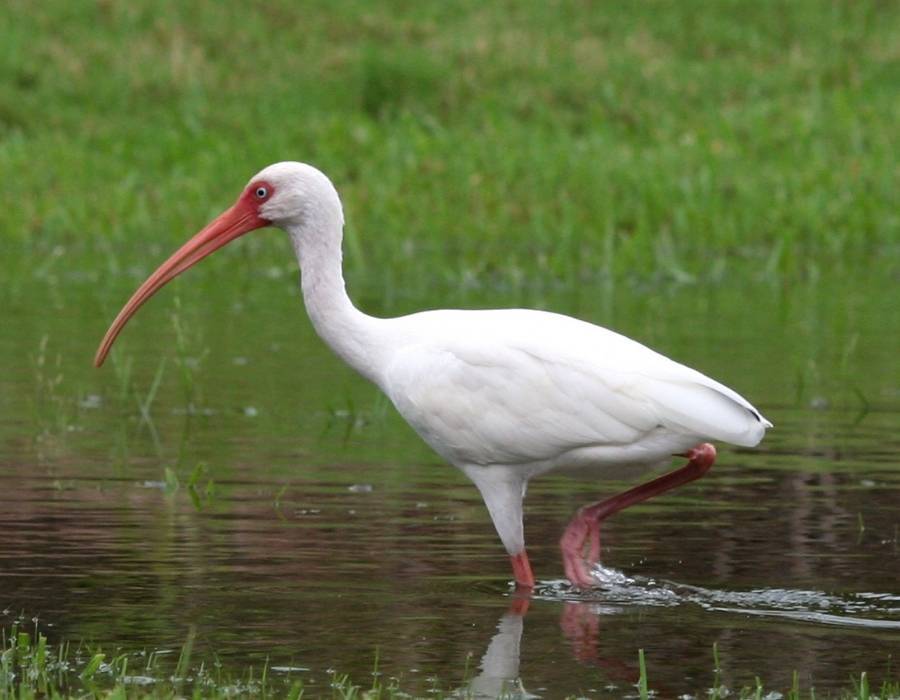
The White Ibis is a medium-small bird, about the size of a crow. When they spread their wings, they appear to have black fingers guiding them along their flight.
- Family: Threskiornithidae
- Size: Small
- Wingspan: 3 ft
- Weight: 2.1lbs
- Body: Medium-sized, straight neck, downward turned beak.
- Tail: Short and straight.
- Diet: Crayfish, crabs, frogs, snails, small fish, insects.
- Habitat: Marshes, mudflats, swamps, rice fields, lagoons.
- Song: Nasal honk, throaty murmurs.
The appearance of this bird is strikingly unique. Most of their body is covered in white feathers, but their legs and face appear bright red-orange. The black fingers are just one of the many traits that make the White Ibis special.
These birds are known for wading in shallow waters, usually in groups of other Ibises.
Click here for more information on the White Ibis.
Further reading
Tundra Swan
The Tundra Swan, a magnificent avian marvel, showcases both grace and grandeur with its large, white stature and long, straight beak. Known for its resounding and melodious calls, this bird’s ethereal presence captures the imagination.
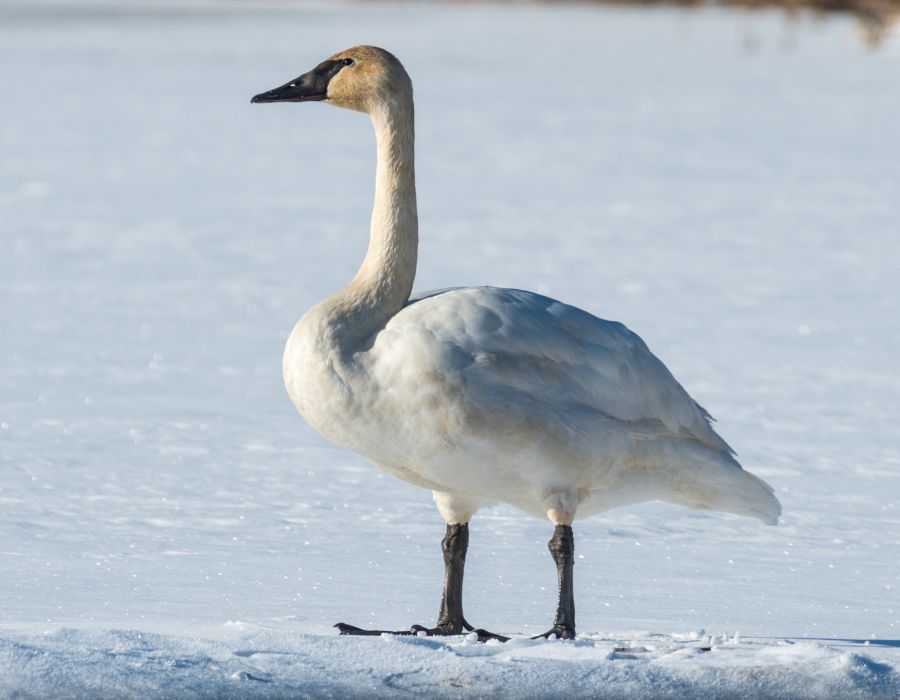
The Tundra Swan is renowned for its incredible migratory journeys, traversing vast distances with unwavering determination. Its long beak serves as a vital tool, enabling the bird to search for food and extract sustenance from its environment.
Spiritually, the Tundra Swan symbolizes grace, beauty, and dream realization, often seen as a guide in spiritual journeys.
Roseate Spoonbill
The Roseate Spoonbill is a truly captivating creature, enchanting observers with its unique appearance and behavior. Cloaked in pinkish-white plumage, this bird is a sight to behold.
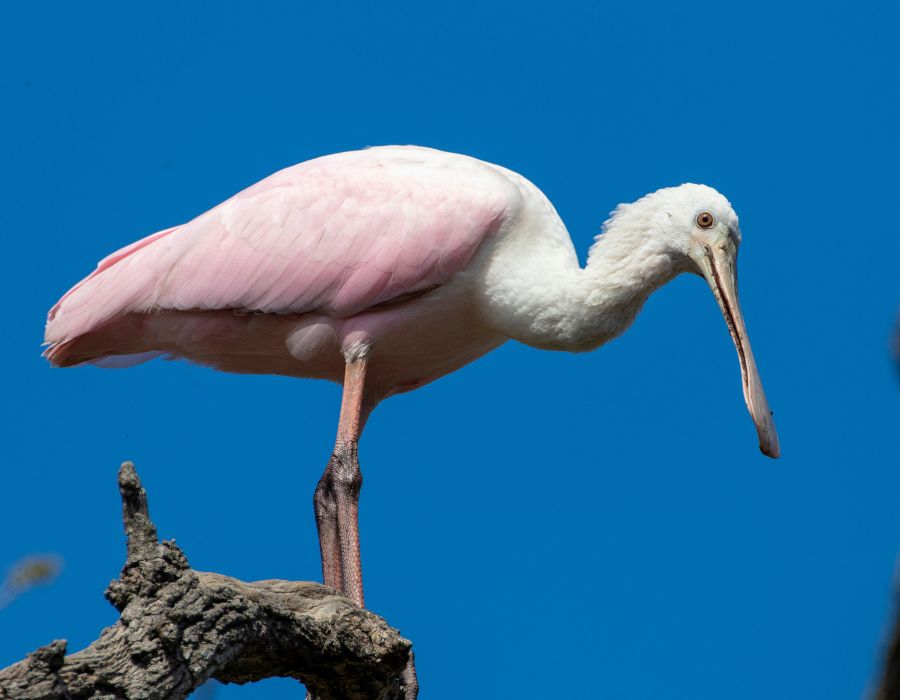
Its long, spoon-shaped beak, which sets it apart from its avian counterparts, is perfectly suited for the Roseate Spoonbill’s foraging technique. With a graceful sweeping motion, the bird sifts through mud and shallow water, delicately skimming its beak to locate prey hidden beneath the surface.
In spiritual symbolism, the Roseate Spoonbill represents peace, harmony, and balance, reflecting its graceful movements and tranquil presence.
Red Crossbill
The Red Crossbill, a small yet fascinating bird, showcases nature’s diversity and ingenuity with its unique beak structure. While its plumage is predominantly white, it is the bird’s distinctive crossed beak that sets it apart.
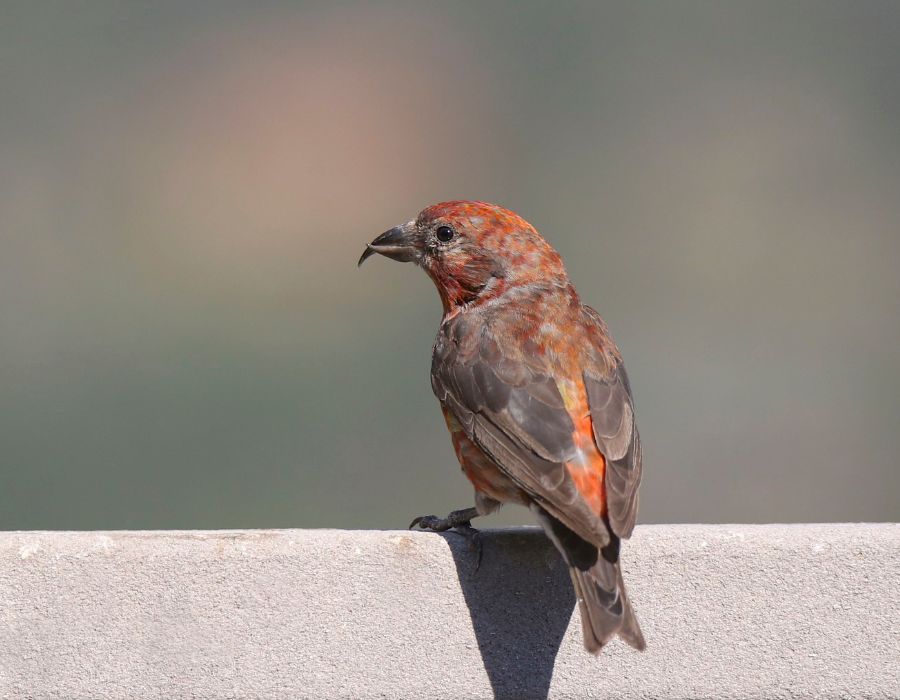
This extraordinary beak shape serves a specific purpose—to extract seeds from cones. The crossed mandibles fit perfectly around the tightly closed cones, allowing the Red Crossbill to pry them open with precision and extract the hidden treasure within.
Spiritually, the Red Crossbill symbolizes the power of adaptation and problem-solving, reflecting its unique beak adaptation and resourceful feeding habits.
Shoebill
The Shoebill is an impressive and enigmatic bird, capturing attention with its large size and distinctive features. Its most notable attribute is its long, shoe-shaped beak, which lends the bird its name.
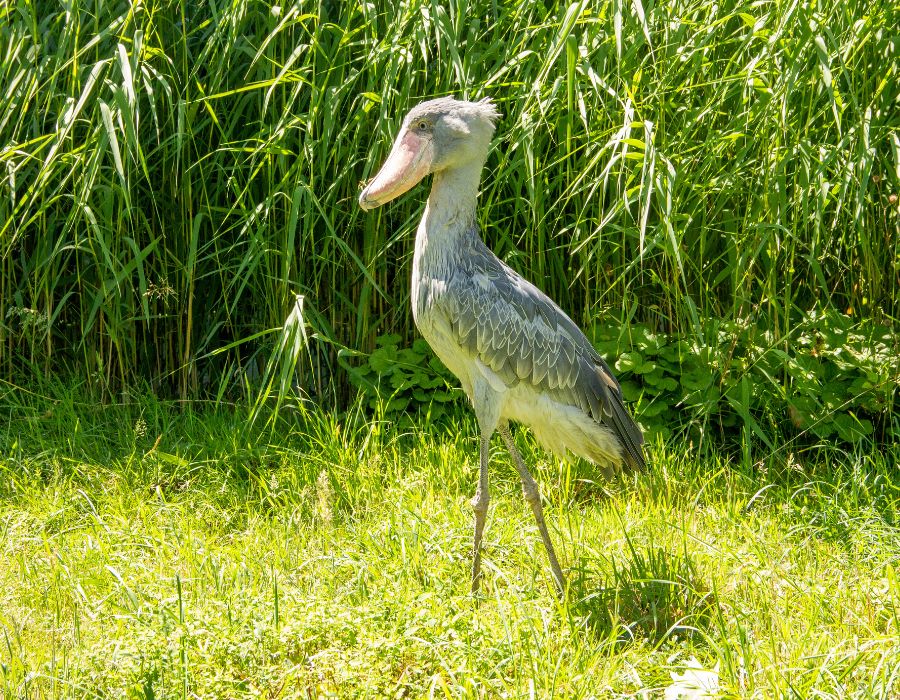
This unique beak plays a vital role in the Shoebill’s hunting strategy. With patience and precision, the bird utilizes its beak to catch and firmly grip its prey, which includes fish, amphibians, and small mammals.
In spiritual symbolism, the Shoebill represents patience, focus, and determination, reflecting its patient hunting techniques and powerful presence.
Long-Billed Curlew
The Long-Billed Curlew is a fascinating bird known for its remarkable beak, which measures exceptionally long and features a distinct curve. This specialized beak plays a crucial role in the bird’s foraging behavior.
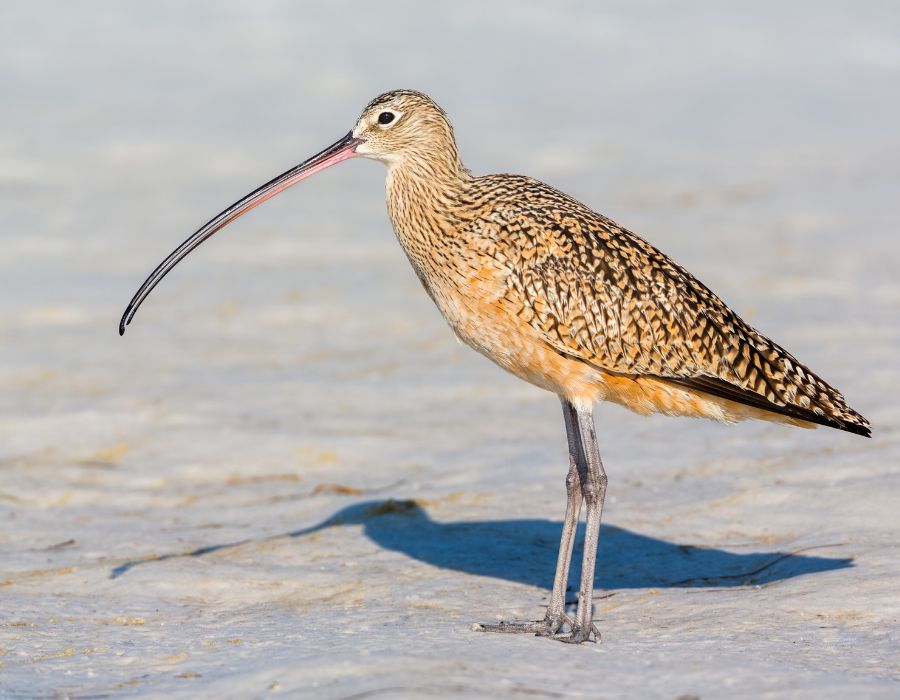
With a probing motion, the Long-Billed Curlew skillfully navigates the ground, searching for insects and small creatures hiding beneath the surface. Its curved beak acts as a precise tool, allowing the bird to extract its prey from the depths of the earth.
Spiritually, the Long-Billed Curlew symbolizes home, love, and protection, often associated with its strong nesting instincts and protective behavior.
Sword-Billed Hummingbird
The Sword-Billed Hummingbird is a remarkable avian species that defies expectations with its extraordinary beak length. This small bird’s beak is actually longer than its own body, making it an extraordinary feat of nature.
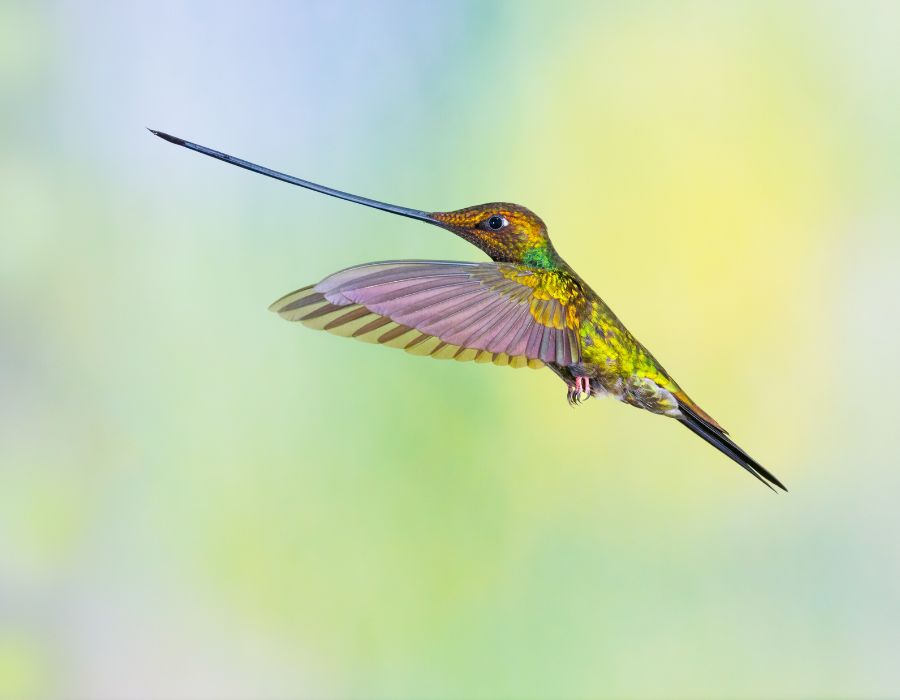
The sword-like beak is perfectly adapted to accommodate the hummingbird’s feeding habits. With its remarkable length, the Sword-Billed Hummingbird can reach the nectar hidden within flowers with long corollas, enabling it to access a niche food source that would be inaccessible to other hummingbird species.
In spiritual symbolism, the Sword-Billed Hummingbird represents agility, joy, and adaptability, reflecting its swift movements and unique feeding habits.
Table: Bird Species and their Remarkable Beak Adaptations
| Bird Species | Beak Length | Adaptation | Symbolic Meaning |
|---|---|---|---|
| American White Pelican | Long | Flat beak for skillful fish scooping | Peace, cooperation, teamwork |
| Wood Stork | Elongated | Curved beak for precise foraging | Birth, renewal, positive changes |
| Cattle Egret | Pointed | Sharp beak for insect capture | Adaptability, resourcefulness |
| Great Egret | Slender | Slender beak for fast strikes | Purity, peace, love |
| White Ibis | Down-curved | Probing beak for extracting prey | Wisdom, knowledge, adaptability |
| Tundra Swan | Long | Straight beak for searching food | Grace, beauty, dream realization |
| Trumpeter Swan | Long | Straight beak for food capture | Power of voice, self-expression |
| Dalmatian Pelican | Long, broad | Broad beak for catching fish | Abundance, resilience, community cooperation |
| Roseate Spoonbill | Spoon-shaped | Spoon-shaped beak for skimming prey | Peace, harmony, balance |
| Rhinoceros Hornbill | Long, curved | Casque and beak for communication | Communication, strength, longevity |
| Red Crossbill | Crossed | Crossed beak for extracting seeds | Adaptation, problem-solving |
| Shoebill | Shoe-shaped | Shoe-shaped beak for gripping prey | Patience, focus, determination |
| Long-Billed Curlew | Long, curved | Curved beak for probing | Home, love, protection |
| Sword-Billed Hummingbird | Long | Extraordinarily long beak for nectar | Agility, joy, adaptability |
Conclusion
In this exploration of the top 15 white birds with long beaks, we’ve journeyed through a fascinating world of avian diversity. From the grace of the American White Pelican to the unique beak of the Sword-Billed Hummingbird, each bird is a testament to nature’s ingenuity.
These birds, with their striking white plumage and long beaks, remind us of the beauty and complexity of the natural world. As we conclude, let’s carry forward this newfound appreciation for these remarkable creatures and the diverse roles they play in our ecosystems.
FAQs
What is a white bird with a long beak?
A white bird with a long beak is a type of bird characterized by its white plumage and elongated beak. These birds, such as the American White Pelican or the Great Egret, use their long beaks for various survival activities like fishing or hunting.
What are white birds with long beaks and legs?
White birds with long beaks and legs are typically wading birds or water birds. Examples include the Great Egret and the White Ibis. These birds use their long legs for wading in water and their long beaks for catching prey.
What bird has the longest beak?
The bird with the longest beak is the Sword-Billed Hummingbird. Its beak is longer than its body, excluding the tail, which allows it to feed on flowers with long corollas.
What are the Florida white birds with long curved beaks?
The Florida white birds with long curved beaks include the American White Ibis and the Roseate Spoonbill. These birds are commonly found in the wetlands of Florida.



